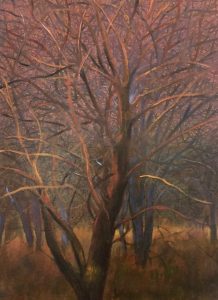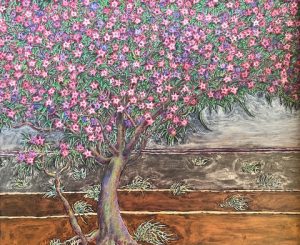Lattices: paintings of mesmerising treescapes by Camille Wekesa at Red Hill Gallery, Nairobi
By James Brewer
From spindly bamboo to bulbous baobab, a haunting variety of noble trees and dream-like landscapes beckons in the latest exhibition by artist and conservation advocate Camille Wekesa celebrating her homeland of Kenya.
Her passion for the fragile biosphere, with its changing moods but eternal poetry blazes forth in 15 canvases on show at the Red Hill Art Gallery in the lush green hills just outside Nairobi.
She calls her collection Lattices, a reference to the extraordinary interlacing of branches and even tree species. Nature’s latticework, unlike that constructed by man, is of an irregular elegance and Camille’s mastery of the play of light creates canvases and panels of uncommon beauty. The trees seem imbued with distinct personalities and given the African context to burst with a spirituality that reflects the religious reverence that communities have had for centuries for the genus.
Because of Covid-19 restrictions a plan to open the exhibition in June was postponed, but the series is now online, and even in that medium exerts a deep fascination.
How city-dwellers have longed this year for the open air! Few places could be more inspiring than the vast high plains of Laikipia, to the north of Nairobi and of Mount Kenya. The region is famed internationally for its plethora of wildlife, but Camille on this occasion is celebrating the fertile tangles that make up its arboreal glory. Her dazzling use of colour catches the clarity of boughs and branches that have been flourishing after much-needed rains put an end to a troublesome drought in the Laikipia area. Near her home at the edge of the Mount Kenya forest reserve more than 50 types of indigenous tree are in their element. “I have not had to go far to find inspiration,” she says, and a short drive away are parks and private conservancies that “have given me ample and rich visual reference.”
Camille respects that many Africans consider trees as sacred – varieties such as the strangler fig tree (which smothers its host tree) which for the Kikuyu, the country’s largest ethnic group, is home to ancestral spirits.
Similarly, the Mijikenda venerate what forests remain along 200 km of coastline where they once lived in fortified villages known as kayas, cultivating them to protect spiritual beliefs and the graves of ancestors.
Another challenge to natural heritage conservation arises at the barren landscape around Lake Turkana, where over perhaps 7m years forest grassland was transformed into petrified forest.
Among Camille’s favourites are the whistling thorn acacia with its swollen black galls which are colonised by stinging ants and which have spines catching the wind to trill like a flute. The majestic baobab is one of the longest-lived trees – in some cases more than 2,000 years – but is under threat. Illustrating how precarious is the ecological balance, some of the oldest baobabs are dying and it is unclear why – climate change is suspected.
To endow a shimmering effect in certain pictures, Camille applies pearl lustre pigments, as with the bejewelled Desert Rose; and Sunlit Acacias, Bamboo Maze, Whistling Thorn Forest and two entitled Majestic Baobab. Ripples gives us a glimpse of a shy group of impala gazelle weaving their way through a skein of forest branches.
Almost everywhere, in or out of the wind, it is the trees which tell the story through their cohabitation with the rest of nature.
Over years of painting the great savannas, says Camille, “I became more interested in depicting the incredible variety of indigenous individual trees and forests and the particular role they play in society; not only protecting us from climate change but giving us shade, beauty, sustenance, medicine, herbs and many other benefits.”
She begins her creative process by painting plein air in oil, ahead of what may be months of elaborate, intricate work in the studio, building up the lattices and layers with either oil on canvas or tempera on panel. The latter is a comparatively new medium for this artist, which the UK public saw in her previous exhibition entitled Jade & Silver at a London gallery in June 2018. “I am interested in the mood and experience created for the viewer that transports them to a place where they can connect to the majesty or uniqueness of a tree or forest.”
Being an African landscape painter means deepening her knowledge of art history of other continents, ranging from Western masters and to the great Chinese landscape paintings in ink.
She has a strong international background, having lived in London, Florence, Rome, Paris, and Milan, and travelling elsewhere in Europe and in the United States, making the most of their cultural offerings and opportunities. She is settled in the Kenyan countryside but hopes to return to New York in 2021 and eventually visit Namibia and Rwanda.
A speciality is decorative large-scale multi-layered murals and she has been commissioned to paint these for private homes and businesses. At her home, she is working on a series of eight indoor murals of iconic Kenyan landscapes, starting with the Aberdare forest range. This “creative journey” is expected to take her six years to complete.
She says: “I am passionate about the conservation of forests and landscapes in Kenya and I see the role of the artist as extremely important in highlighting environmental issues and bringing awareness to the need to preserve and protect these stunning habitats and forests.”
Since 2016, Camille has been coordinating and leading fellow artists in art education combined with environmental awareness at schools in Laikipia. The scheme is supported by Lewa Conservancy and the Matisse Foundation.
Through her company website www.orkedi.com she is documenting her work and that of others. This is helping build a collection of site-specific work of African painters, sculptors, and photographers.
In an interview with Rupi Mangat, a Kenyan travel writer specialising in wildlife conservation and sustainability, on the site https://rupitheafricantrotter.com Camille said: “I want to help keep art made and created in Kenya in the country and help the industry together with other artists to continue to build collections of art in Kenya and on the continent too.”
Red Hill Gallery is devoted to African art and owns a large collection, amassed over 25 years by the owners, that it says amounts to a cross-section of the finest modern and contemporary African artwork.
The exhibition runs until October 18, 2020.
For more information about Camille Wekesa and her art and projects, please see www.orkedi.com











